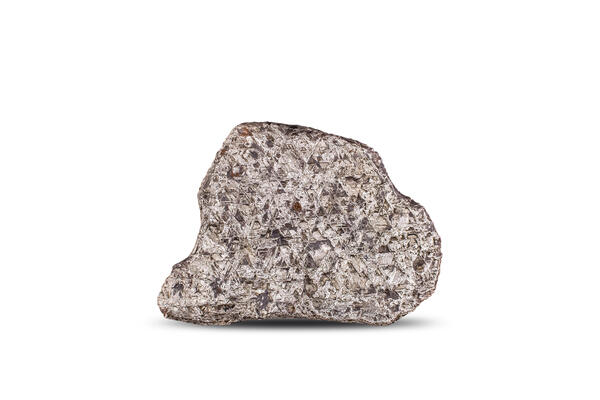The Muonionalusta meteorite is the oldest meteorite that is known to modern science. It is more than 4 billion years old and it fell 15,000 to 800,000 years ago. The numerous fragments of the bolide shattered over an area of about 400 square kilometers.
The first fragments of this meteorite were discovered in 1906, near the Sweden-Finland border. It was named after the Muonio River, which flows in this area. In 1909, Gustaf Högbom, professor of geology and mineralogy at Uppsala University, was the first to analyze the meteorite samples and determine that it is an octahedrite. Octahedrites are iron celestial objects, which contain between 6% to 13% nickel. Probably Muonionalusta used to be part of the core of a small planet. In total, scientists found more than 20 tons of its fragments on the banks of the Muonio River.
The iron-nickel alloy in the composition of this meteorite occurs in two forms — taenite and kamacite. Their crystals grew and gradually penetrated each other, thereby the so-called Widmanstätten figures appeared — a typical geometric pattern of straight lines and intertwined triangles. Usually, in meteorite fragments, such a pattern is visible on the cuts, but in the Muonionalusta they are visible even on the surface.
This meteorite is composed of 90% iron and 8.4% nickel. The rest is made up of iridium, gallium, and germanium. In addition, stishovite was discovered in Muonionalusta. Stishovite a type of silicon oxide, which is often found in stone meteorites. Thus, it was found for the first time in an iron meteorite.
Iron meteorites, which include Muonionalusta, rarely fall on Earth: they make up only 5-6% of all such celestial objects. Most often stone meteorites fall. In their composition, they resemble the Earth’s crust. Scientists believe that in total about 6 tons of such bodies per day or 2 thousand tons per year fall on Earth. But not all of them can be found: some of them sink into the oceans, while others end up in uninhabited deserts, forests, or arctic zones.
When meteorites enter the atmosphere, they begin to glow brightly. From the ground, it looks like a star is moving across the sky. This phenomenon is called a meteor shower.
The first fragments of this meteorite were discovered in 1906, near the Sweden-Finland border. It was named after the Muonio River, which flows in this area. In 1909, Gustaf Högbom, professor of geology and mineralogy at Uppsala University, was the first to analyze the meteorite samples and determine that it is an octahedrite. Octahedrites are iron celestial objects, which contain between 6% to 13% nickel. Probably Muonionalusta used to be part of the core of a small planet. In total, scientists found more than 20 tons of its fragments on the banks of the Muonio River.
The iron-nickel alloy in the composition of this meteorite occurs in two forms — taenite and kamacite. Their crystals grew and gradually penetrated each other, thereby the so-called Widmanstätten figures appeared — a typical geometric pattern of straight lines and intertwined triangles. Usually, in meteorite fragments, such a pattern is visible on the cuts, but in the Muonionalusta they are visible even on the surface.
This meteorite is composed of 90% iron and 8.4% nickel. The rest is made up of iridium, gallium, and germanium. In addition, stishovite was discovered in Muonionalusta. Stishovite a type of silicon oxide, which is often found in stone meteorites. Thus, it was found for the first time in an iron meteorite.
Iron meteorites, which include Muonionalusta, rarely fall on Earth: they make up only 5-6% of all such celestial objects. Most often stone meteorites fall. In their composition, they resemble the Earth’s crust. Scientists believe that in total about 6 tons of such bodies per day or 2 thousand tons per year fall on Earth. But not all of them can be found: some of them sink into the oceans, while others end up in uninhabited deserts, forests, or arctic zones.
When meteorites enter the atmosphere, they begin to glow brightly. From the ground, it looks like a star is moving across the sky. This phenomenon is called a meteor shower.



